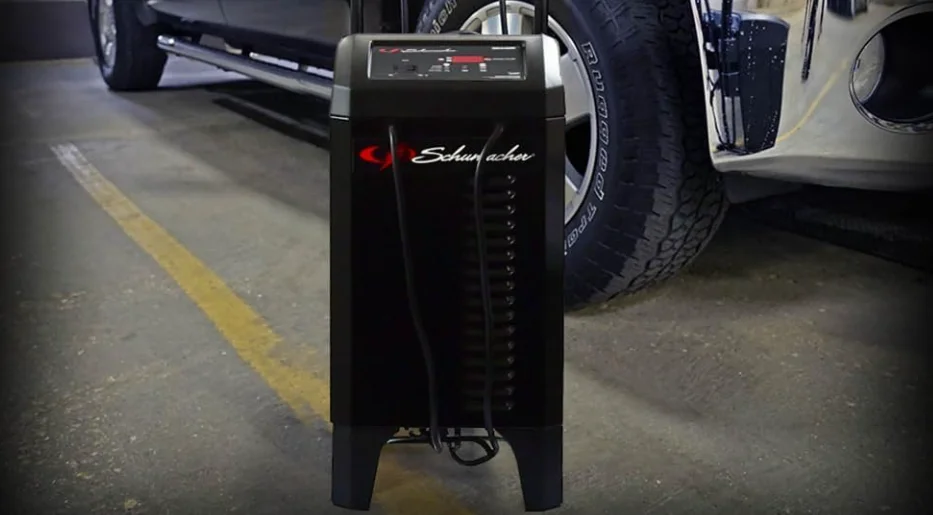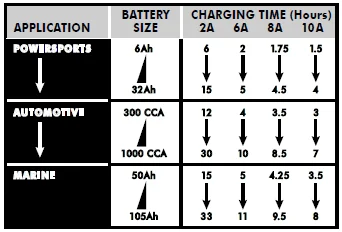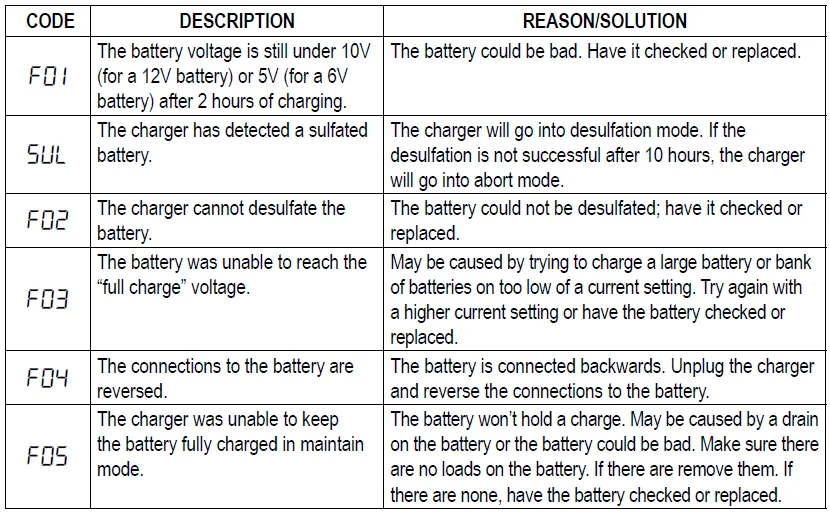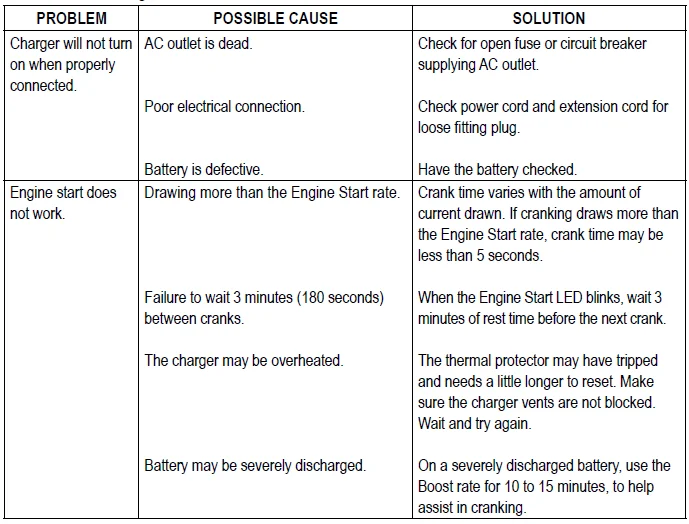
Schumacher SC1632 Auto Battery Charger
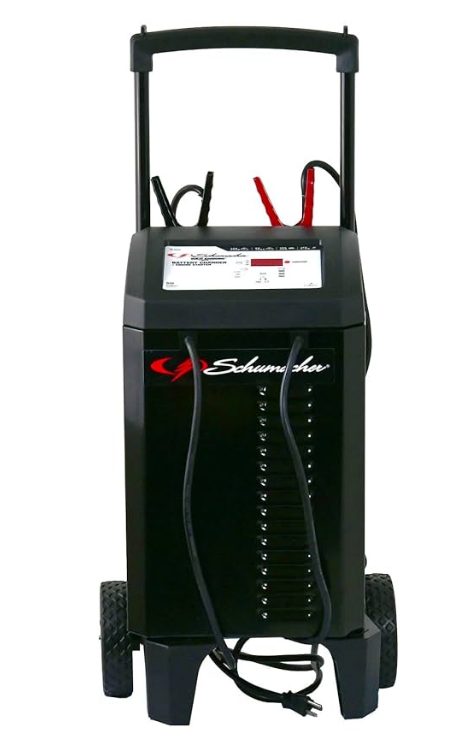
IMPORTANT SAFETY INSTRUCTIONS – SAVE THESE INSTRUCTIONS
- This manual contains important safety and operating instructions.
- Keep out of reach of children.
- Do not expose the charger to rain or snow.
- Use of an attachment not recommended or sold by the battery charger manufacturer may result in a risk of fire, electric shock, or injury to persons.
- To reduce the risk of damage to the electric plug and cord, pull the plug rather than the cord when disconnecting the charger.
- An extension cord should not be used unless absolutely necessary. Use of an improper extension cord could result in a risk of fire and electric shock. If an extension cord must be used, make sure:
- The pins on the plug of the extension cord are the same number, size, and shape as those of the plug on the charger.
- The extension cord is properly wired and in good electrical condition.
- The wire size is large enough for the AC ampere rating of the charger as specified in section 8.
- Do not operate a charger with a damaged cord or plug – replace the cord or plug immediately.
- Do not operate the charger if it has received a sharp blow, been dropped, or otherwise damaged in any way; take it to a qualified serviceman.
- Do not disassemble the charger; take it to a qualified serviceman when service or repair is required. Incorrect reassembly may result in a risk of electric shock or fire.
- To reduce the risk of electric shock, unplug the charger from the outlet before attempting any maintenance or cleaning. Turning off controls will not reduce this risk.
PERSONAL SAFETY PRECAUTIONS
- Consider having someone close enough by to come to your aid when you work near a lead-acid battery.
- Have plenty of fresh water and soap nearby in case battery acid contacts skin, clothing, or eyes.
- Wear complete eye protection and clothing protection. Avoid touching your eyes while working near a battery.
- If battery acid contacts skin or clothing, wash immediately with soap and water. If acid enters the eye, immediately flood the eye with running cold water for at least 10 minutes and get medical attention immediately.
- NEVER smoke or allow a spark or flame in the vicinity of the battery or engine.
- Be extra cautious to reduce the risk of dropping a metal tool onto the battery. It might spark or short-circuit the battery or other electrical parts, which may cause an explosion.
- Remove personal metal items such as rings, bracelets, necklaces, and watches when working with a lead-acid battery. A lead-acid battery can produce a short-circuit current high enough to weld a ring or the like to metal, causing a severe burn.
PREPARING TO CHARGE
- If necessary to remove the battery from the vehicle to charge, always remove the grounded terminal from the battery first. Make sure all accessories in the vehicle are off, so as not to cause an arc.
- Be sure the area around the battery is well ventilated while the battery is being charged.
- Clean battery terminals. Be careful to keep corrosion from coming in contact with your eyes.
- If applicable, add distilled water in each cell until the battery acid reaches the level specified by the battery manufacturer. Do not overfill. For a battery without removable cell caps, such as valve-regulated lead-acid batteries, carefully follow the manufacturer’s recharging instructions.
- Study all battery manufacturers’ specific precautions while charging and recommended rates of charge.
- Determine the voltage of the battery by referring to the car owner’s manual, and make sure that the output voltage selector switch is set at the correct voltage. If the charger has an adjustable charge rate, charge the battery initially at the lowest rate.
CHARGER LOCATION
- Locate the charger as far away from the battery as DC cables permit.
- Never place a charger directly above a battery being charged; gases from the battery will corrode and damage the charger.
- Never allow battery acid to drip on the charger when reading electrolyte specific gravity or filling the battery.
- Do not operate the charger in a closed-in area or restrict ventilation in any way.
- Do not set a battery on top of a charger.
DC CONNECTION PRECAUTIONS
- Connect and disconnect DC output clips only after setting any charger switches to the “off” position and removing the AC cord from the electric outlet. Never allow the clips of the charger to touch each other. Clips may be energized, and they may spark.
- Attach clips to the battery and chassis, as indicated in sections 6 and 7.
GROUNDING AND AC POWER CORD CONNECTIONS
- This battery charger is for use on a nominal 120-volt circuit and has a grounded plug. The charger must be grounded to reduce the risk of electric shock. The plug must be plugged into an outlet that is properly installed and grounded in accordance with all local codes and ordinances. The plug pins must fit the receptacle (outlet). Do not use with an ungrounded system.
- DANGER: Never alter the AC cord or plug provided – if it does not fit the outlet, have a proper grounded outlet installed by a qualified electrician. An improper connection can result in a risk of an electric shock or electrocution. NOTE: Pursuant to Canadian Regulations, use of an adapter plug is not allowed in Canada. Use of an adapter plug in the United States is not recommended and should not be used.
- USING AN EXTENSION CORD
The use of an extension cord is not recommended. If you must use an extension cord, follow these guidelines:
- Pins on the plug of the extension cord must be the same number, size, and shape as those of the plug on the charger.
- Ensure that the extension cord is properly wired and in good electrical condition.
- Wire size must be large enough for the AC ampere rating of the charger, as specified:

ASSEMBLY INSTRUCTIONS
- It is important to fully assemble your charger before use. Remove all cord wraps and uncoil the cables prior to using the battery charger. Follow these instructions for assembly.

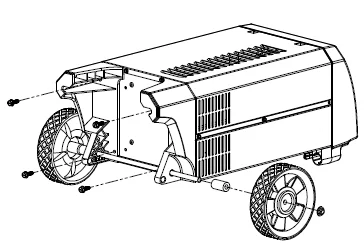
- Attach the feet: Remove the charger from the packing materials and place it back down on a flat surface. Attach the feet and secure them with the four 1/4-20 x 3/4˝ screws provided. Attach wheels to the axle.
- Extend the handle from the retracted position by pulling it upward until it locks into place. (Press the small silver buttons inward, if necessary.)
CONTROL PANEL
DIGITAL DISPLAY
The Digital gives a digital indication of voltage, % of charge, or current in amps. It also gives the cool-down time remaining during Engine Start. When chosen by the Display Button, the display will show the battery voltage, % of charge, or current in amps under certain conditions. First, when connected to a battery but not charging, all options but current in amps are available. When charging begins, the display will automatically change to the Voltage option, show On to indicate charging has started, and then either 6 or 12, the voltage type of the battery determined by the charger. If the battery voltage is low, the display will continue to show On until the voltage type is determined. % of charge is an option only after the voltage type, 6 or 12, is determined, and also only for the Charge rate. The Amps option is available anytime during charging. When the battery is fully charged, indicated by the Charged/Maintaining (green) LED being lit, the display and all other LEDs will turn off to conserve energy during Maintain mode.
DISPLAY BUTTON
Use this button to set the function of the digital display to one of the following:
Battery %
The digital display shows an estimated charge percentage of the battery connected to the charger’s battery clamps.
Amps
The display shows the output current, in amps.
Voltage
The Digital Display shows the voltage at the charger battery clamps, in DC volts.
RATE SELECTION BUTTON
Use this button to select one of the following rates:
Charge/Maintain
For charging small and large batteries. Not recommended for industrial applications.
Boost
For quickly adding energy to a severely discharged or large capacity battery prior to Engine Start.
Engine Start
Provides additional amps for cranking an engine with a weak or run-down battery. Always use it in combination with a battery.
START/STOP BUTTON
Press to immediately begin charging your properly connected battery. If the button is not pressed, charging should begin automatically in 30 seconds.
LED INDICATORS
- CHARGING (yellow/orange) LED lit: The charger is charging the battery.
- CHARGED/MAINTAINING (green) LED lit: The battery is fully charged and the charger is in maintain mode. NOTE: The display and all other LEDs will be off when this LED is lit, to conserve energy.
- BAD BATTERY/CLAMPS REVERSED (red) LED lit: The charger has detected a problem with the battery. See Troubleshooting for more information.
- BAD BATTERY/CLAMPS REVERSED (red) LED flashing: The connections are reversed.
NOTE: See Operating Instructions for a complete description of the charger modes.
BATTERY TYPE BUTTON
Use this button to select the type of battery.
STD
Used in cars, trucks, and motorcycles, these batteries have vent caps and are often marked “low maintenance” or “maintenance-free”. This type of battery is designed to deliver quick bursts of energy (such as starting engines) and has a greater plate count. The plates are thinner and have somewhat different material composition. Standard batteries should not be used for deep-cycle applications.
AGM
The Absorbed Glass Mat construction allows the electrolyte to be suspended in close proximity to the plate’s active material. In theory, this enhances both the discharge and recharge efficiency. The AGM batteries are a variant of Sealed VRLA (valve-regulated lead-acid) batteries. Popular uses include high-performance engine starting, powersports, deep-cycle, solar, and storage batteries.
GEL
The electrolyte in a GEL cell has a silica additive that causes it to set up or stiffen. The recharge voltages on this type of cell are lower than those for other styles of lead-acid battery. This is probably the most sensitive cell in terms of adverse reactions to overvoltage charging. Gel batteries are best used in VERY DEEP cycle applications and may last a bit longer in hot weather applications. If the wrong battery charger is used on a gel cell battery, poor performance and premature failure will result.
OPERATING INSTRUCTIONS
WARNING: A SPARK NEAR THE BATTERY MAY CAUSE AN EXPLOSION.
CHARGING A BATTERY IN THE VEHICLE
- Turn off all the vehicle’s accessories.
- Access the battery; keep the area open.
- Clean the battery terminals.
- Place the charger on a dry, non-flammable surface.
- Lay the AC/DC cables away from any fan blades, belts, pulleys, and other moving parts.
- Connect the battery, following the precautions listed in sections 6 and 7.
- Connect the charger to a live, grounded 120V AC outlet.
- Select the battery type and charge rate.
- Press the START button to begin charging immediately. If not pressed within 30 seconds, charging will begin immediately. With the Charge rate selected, charging of the battery will automatically complete. Even with the Charge rate selected, the charger will automatically use the Boost rate during the first 10 minutes, if needed, and then switch to the Charge rate to charge the battery efficiently.
- When charging is complete, indicated by the Charged/Maintaining LED lit, or if you are done, press the STOP button, disconnect the charger from the AC power, disconnect the clamp attached to the vehicle’s chassis, and finally remove the clamp from the battery terminal.
CHARGING A BATTERY OUTSIDE OF THE VEHICLE
- Place the battery in a well-ventilated area.
- Clean the battery terminals.
- Connect the battery, following the precautions listed in sections 6 and 7.
- Connect the charger to a live grounded 120V AC outlet.
- Select the battery type and charge rate.
- Press the START button to begin charging immediately. If not pressed within 30 seconds, charging will begin immediately. With the Charge rate selected, charging of the battery will automatically complete. Even with the Charge rate selected, the charger will automatically use the Boost rate during the first 10 minutes, if needed, and then switch to the Charge rate to charge the battery efficiently.
- When charging is complete, indicated by the Charged/Maintaining LED lit, or if you are done, press the STOP button, disconnect the charger from the AC power, disconnect the negative clamp, and finally, the positive clamp.
- A marine (boat) battery must be removed and charged on shore.
BATTERY CHARGING TIMES
Times are based on a 50% discharged battery and may change, depending on the age and condition of the battery.
AUTOMATIC CHARGING MODE
When the Charge/Maintain rate is selected, the charger switches to the maintain mode automatically after the battery is charged.
ABORTED CHARGE
If charging cannot be completed normally, charging will abort. When charging aborts, the charger’s output is shut off. The digital display will show FNN, where nn is an error code (see Troubleshooting for a description of the error codes). Do not continue attempting to charge this battery. Have it checked or replaced.
DESULFATION MODE
Desulfation could take 8 to 10 hours. If desulfation fails, the display will show F02, charging will abort, and the Bad Battery/Reversed Clamps (red) LED will light.
COMPLETION OF CHARGE
Charge completion is indicated by the Charged/Maintaining (green) LED. When lit, the charger has switched to the maintain mode of operation.
MAINTAIN MODE (FLOAT MODE MONITORING)
When the Charged/Maintaining (green) LED is lit, the charger has started maintenance mode. In this mode, the charger keeps the battery fully charged by delivering a small current when necessary. If the charger has to provide an excessive maintenance current for a continuous 12-hour period, it will go into abort mode (see Aborted Charge section). This is usually caused by a drain on the battery, or the battery could be bad.
MAINTAINING A BATTERY
The unit charges and maintains 6V and 12V batteries.
NOTE: The maintain mode technology allows you to safely charge and maintain a healthy battery for extended periods of time. However, problems with the battery, electrical problems in the vehicle, improper connections, or other unanticipated conditions could cause excessive current draws. As such, occasionally monitoring your battery and the charging process is required.
USING THE ENGINE START FEATURE
Your battery charger can be used to jump-start your car if the battery is low. Follow all safety instructions and precautions for charging your battery. Wear complete eye protection and protective clothing.
WARNING: Using the Engine Start feature WITHOUT a battery installed in the vehicle could cause damage to the vehicle’s electrical system.
NOTE: If you have charged the battery and it still will not start your car, do not use the Engine Start feature, or it could damage the vehicle’s electrical system. Have the battery checked.
- With the charger unplugged from the AC outlet, connect the charger to the battery following the instructions given in Follow These Steps When Battery is Installed in Vehicle.
- Connect the charger to a live grounded 120V AC outlet.
- With the charger plugged in and connected to the battery and chassis, press the Rate Selection button until the Engine Start LED is lit, and then press the START button.
- Crank the engine until it starts or 7 seconds pass. If the engine does not start, repeat. Do not crank during the cool-down period (see below). This allows the charger and battery to cool down. NOTE: During extremely cold weather or if the battery is under 2 volts, charge the battery for 5 minutes before cranking the engine.
- If the engine fails to start, charge the battery for 5 more minutes before attempting to crank the engine again.
- After the engine starts, unplug the AC power cord before disconnecting the battery clamps from the vehicle.
- Clean and store the charger in a dry location.
NOTE: If the engine does turn over but never starts, there is not a problem with the starting system; there is a problem somewhere else with the vehicle. STOP cranking the engine until the other problem has been diagnosed and corrected.
TROUBLESHOOTING AND ERROR CODES
Error Codes
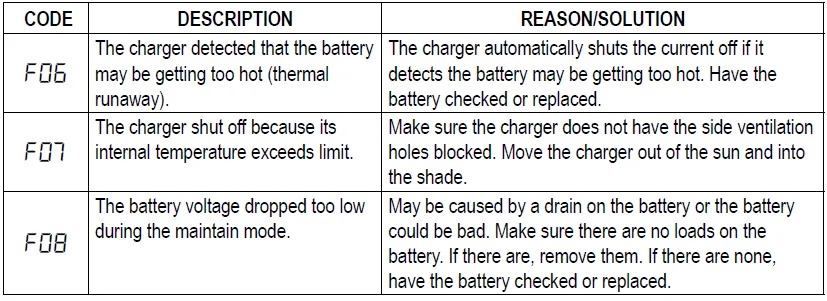
Troubleshooting
BEFORE RETURNING FOR REPAIRS
For REPAIRS OR RETURNS, visit 365rma.com
Visit batterychargers.com for Replacement Parts.
For more Manuals by Schumacher, visit ManualsLibraryy
Schumacher SC1632 Auto Battery Charger-FAQs
Is Schumacher a reliable battery charger brand?
Yes. Schumacher chargers are well-known for efficient charging, ease of use, and long-lasting performance, especially for occasional vehicle use.
Is the SC1632 battery charger automatic or manual?
The SC1632 is fully automatic. It stops charging when the battery is full and switches to maintain (float) mode to prevent overcharging.
Can it charge a completely dead battery?
Yes. The SC1632 can revive fully discharged batteries, making it suitable for batteries that won’t start a vehicle.
How do I know when my battery is fully charged?
The charger has indicator lights that show charging status. A green light usually means the battery is fully charged, while red indicates charging is in progress.
Is it safe to leave the charger connected overnight?
Yes, with automatic chargers like the SC1632, it’s safe because they switch to maintain mode after full charge. However, always follow safety guidelines.
How long does it take to charge a car battery?
Charging time depends on the battery size and condition. A fully drained 12V battery may take several hours on standard modes, while rapid charge modes reduce the time.
Can I start my car while the charger is connected?
Yes, you can start your car while connected. Ensure the cables are clear of moving parts under the hood.
How do I reset the charger if it’s not working?
Unplug the charger, inspect cables and connections, check fuses, and then plug it back in. Refer to the user manual for detailed troubleshooting steps.
What size battery can I charge with this unit?
The SC1632 supports standard 12V lead-acid batteries. Choose the charging mode according to your battery’s amp-hour (Ah) rating.
How can I prevent my car battery from going flat when not in use?
Use the maintain mode on the charger, disconnect devices that drain power when the car is off, and avoid leaving electronics on without the engine running.

